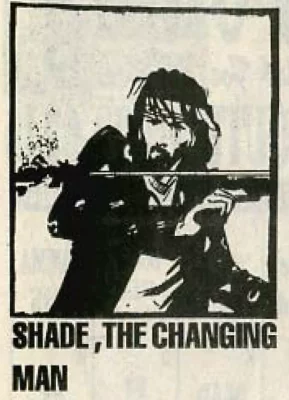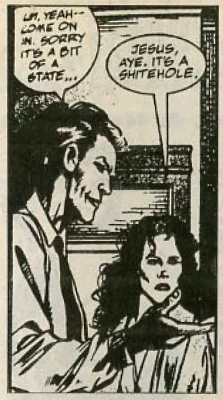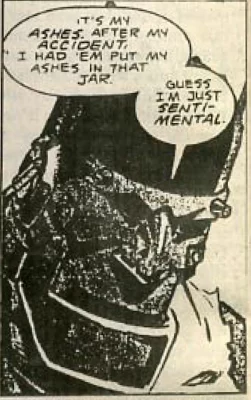Comics: November 1991
Archived
 Shade, The Changing Man
Shade, The Changing Man
In this title, comics veteran Peter Milligan has taken a lousy character with lame premise (both created by comics legend Steve Ditko) and breathed astonishing new life into the character and concept.
In Shade, an outcast from the world of Meta has unwittingly created a being dubbed the “American Scream,” the “Scream” being the embodiment of all that is “bad” in America (racism, greed, sloth, etc). Shade, an agent from Meta, is dispatched to Earth via “the Madness Zone” to deal summarily with the “Scream.” Armed only with the madness Vest, which allows him to manifest creations from his mind, Shade inhabits the body of Troy Grenzer, a vicious killer on death row.
In seeking to defeat the “American Scream,” Shade has befriended a young woman whose name is Kathy, Coincidentally, her parents and lover were murdered by Grezner. Together, Shade and Kathy have traversed most of the US in pursuit of an end to “the madness.”
Writer Milligan, from Ireland, wields a sharp wit and incisive intellect in this series. The persona of America is laid bare and dissected. Surprisingly, Milligan is able to view America from a detached distance, and in doing so, characterizes this country with startling clarity—the subject matter alone should have even the most staunch patriot thinking about American Values.
In addition, though, Milligan has also injected healthy characterizations into both Shade and Kathy and the latter’s struggle against alcoholism is realistic (a welcome difference to most lame stories on the subject). The merits to this approach make the reader feel the power of the tale that much more poignantly
But penciller Chris Bachalo also observes note for conveying Milligon’s powerful imagery on the printed page. In his 17 issues, Bachalo has made great strides as an illustrator. Unfortunately, inker Mark Pennington has a tendency to overwhelm Bachalo’s delicate renderings. Current guest-inker Rick Bryant is much more complementary, as recent issues will attest.
Even better than the interiors are the covers by Brendam McCarthy and Tank Girl artist Jamie Hewlett, however. They are at once startling and evocative and serve to draw the eyes of casual browsers to this comic.
Preposterous it may sound, but those looking for something substantial from DC Comics should give Shade a chance. (color—$1.75)
John Constantine, Hellblazer
 Like Mulligan, Irish writer Garth Ennis has taken a two-dimensional character and breathed new life into him.
Like Mulligan, Irish writer Garth Ennis has taken a two-dimensional character and breathed new life into him.
In this case, the character is John Constantine, the “bad boy” of DC’s horror titles. But throughout all of his appearances, Constantine had been a mystery while writers had emphasized the “asshole” side of his personality.
In recent issues, though, Constantine has come to the brink of Hell. Seems his habit of smoking “three packs a day” has left him with a case of terminal lung cancer. Worse, however, Constantine’s past actions haven’t exactly left him in Hell’s good graces and an unpleasant reward faces him in the afterlife. So…Constantine, with typical aplomb, sets out to put his affairs in order and tries to outwit death. Does he succeed? That would be telling …
The current issue, #48, sees Constantine settled after recent events, visiting a pub with a woman named Kit who really knows him. While the reader watches her drink him under the table, that bit of story takes a back seat to the tale of the Northampton Arms and its manager, Laura.
Longtime readers of the character may be a bit put-off by Ennis’ new “kinder and gentler” Constantine. Sure, he’s still a jerk and a user, but his actions and attitude appear to be a product of his environment and circumstances rather than boorishness.
Likewise, Ennis has toned down the overt nature of horror in the stories. While fantastic elements are still around, they remain largely unseen. Thus, they become that much more powerful, if not tantalizing. For Ennis, there is horror to be found in mundane aspects of life, like cancer and growing old alone, too. Even better still, Ennis displays great skill at dialogue and characterization.
The artistic partner in this revitalization, penciller Will Simpson is passable if unspectacular. The art does manage to convey the simplicity and humanity of normal existence, but falls short in depicting those rare scenes of phantasmagoric horror. In addition, the inking of Mark Pennington and Stan Woch over renders entire scenes, leaving the art looking largely sloppy.
Fortunately, the story more than makes up for this deficiency. Those who think they know Constantine are in for a surprise as well as those who are discovering this title just now. (color—$1.75)
Doom Patrol
 This super-hero title has probably gotten more attention than any of DC’s other “New Format” comics, largely due to its outrageous Scottish writer, Grant Morrison.
This super-hero title has probably gotten more attention than any of DC’s other “New Format” comics, largely due to its outrageous Scottish writer, Grant Morrison.
In taking the Doom Patrol back to its roots (as a weird experience), Morrison has updated this “weirdness” for the ‘90s, as well as expanding on it.
Perennial Doom Patrol member Cliff Steele is still around, but his experiences have left him neurotic. Likewise, team founder the Chief has mysteriously reappeared after his supposed demise and his actions are more than slightly suspect. Around these two, new recruits have appeared in the forms of Crazy Jane (a sufferer of multiple personality disorder, each personality having a distinct “superpower), Dorothy Spinner (a literal ape-faced young girl with the ability to create fantastic creatures from her psyche), and Rebis (the latest incarnation of former DP member Negative Man/Negative Woman).
In 30 issues, Morrison has confronted the Doom Patrol with foes like the cult of the Unwritten Book, the Scissormen, the men from N.O.W.H.E.R.E. and (favorites) the brotherhood of Dada, fronted by Mr. Nobody. Frankly, the strangeness in all this can be (occasionally) overwhelming, but the contrast to “ordinary” super-heroic is quirky and fascinating. The book is at once grotesque and humorous, with jaded observer Cliff Steele commenting on all the absurdity with occasional expletives.
Unfortunately, the art in Doom Patrol is unusually weak. Penciller Richard Case’s two-dimensional, stiff figures do little to give any feeling to the book. Facial expressions, in particular, are lacking. Worse, though, Case cannot even adequately render the insane events which occur, leaving the writing to carry Bisley’s gorgeous paintings. If DC could match the interior work with Bisley’s covers, the title would be stunning.
Nevertheless, the nonsensical nature of the book, coupled with writer Morrison’s sly wit, make Doom Patrol an engrossing read. (color—$1.50)
For more from SLUG’s Archives:
